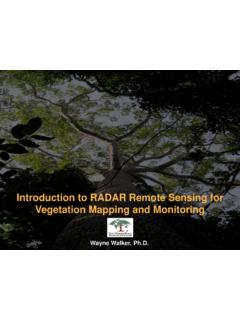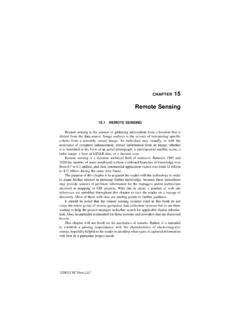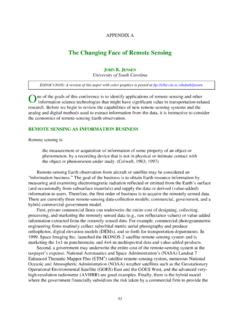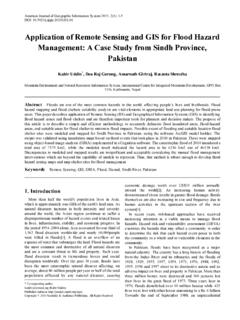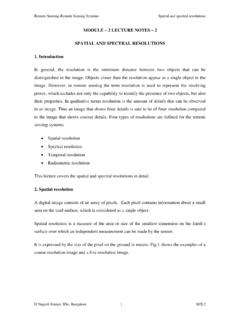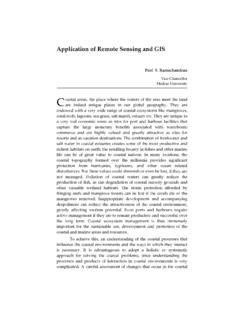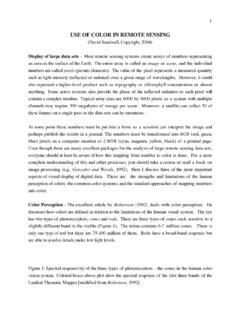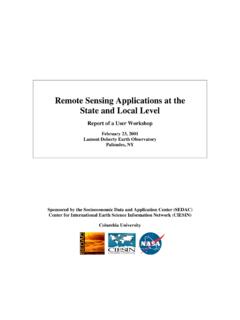Transcription of Introduction to SAR Remote Sensing - Earth Online …
1 Introduction to SAR Remote SensingThuy Le ToanSeptember 3, 2007 Lecture D1La1 September 3, 2007 Lecture D1La1 Introduction to SAR Remote Sensing Thuy Le Toan Introduction to radar Remote Sensing The Synthetic Aperture Radar Geometric properties of SAR images Statistic properties of SAR measurements Physical content of SAR dataContentsSeptember 3, 2007 Lecture D1La1 Introduction to SAR Remote Sensing Thuy Le Toan Introduction to radar Remote Sensing The Synthetic Aperture Radar Geometric properties of SAR images Statistic properties of SAR measurements Physical content of SAR dataContentsSeptember 3, 2007 Lecture D1La1 Introduction to SAR Remote Sensing Thuy Le ToanNon-Imaging(ex.)
2 Microwave radiometer, magnetic sensor)Imaging (ex: cameras, optical mechanical scanner, spectrometer, microwave radiometer)PASSIVE SENSORSD etect the reflected or emitted electromagnetic radiation from natural SENSORSD etect reflected responses from objects irradiated by artificially-generated energy ( ex: microwave radiometer, microwave altimeter, laser)Imaging (Real Aperture Radar,SyntheticAperture Radar)RADAR: Radio Detection and RangingSLAR: Side Looking Airborne Radar, developed during the World War II, for allweather and day and night aircraft operations over land and sea, SAR: Synthetic Aperture Radar, airborne systems developed in 1950 sSAR.
3 Active microwave imaging systemSeptember 3, 2007 Lecture D1La1 Introduction to SAR Remote Sensing Thuy Le ToanRadar Remote sensingSeptember 3, 2007 Lecture D1La1 Introduction to SAR Remote Sensing Thuy Le ToanFrequency bandKaKKuXCSLPW avelength (cm) -3030 -100 Frequency (GHz)40 - - 1818 - -88 - 44 - 22 - 11 - frequencyf (in Hertz)=C/ C= =wavelength in mSeptember 3, 2007 Lecture D1La1 Introduction to SAR Remote Sensing Thuy Le ToanSpaceborneSpaceborneSARsSARsSatellit e Years Agency Frequency - Polarisation Resolution - Swath Special ERS-1 1991-2000 ESA C - VV 25 m 100 km Interferometry (with ERS-2) JERS 1992-1998 NASDA L-HH 25 m 100 km Region.
4 Mosaic available ERS-2 1995 ESA C - VV 25 m 100 km Interferometry (with ERS-1) RADARSAT-1 1995 CSA C - HH 10 -100 m 45 - 500 kmMulti-incidenceENVISAT - ASAR 2002 ESA C - HH/VV/HV 25 - 1000 m50 - 500 kmMulti-incidenceALOS - PALSAR 2006 JAXA L - Polarimetric 10 - 100 m 100 - 350 km Multi-incidenceTerraSAR-X Cosmo-Skymed 2007 DLR Italy X-Polarimetric 1 m Interferometry (1 day) RADARSAT 2 2008 ? CSA C - Polarimetric < 10 m Multi-incidence September 3, 2007 Lecture D1La1 Introduction to SAR Remote Sensing Thuy Le ToanCharacteristics of radar Remote sensingAdvantages compared to optical Remote Sensing all weather capability (small sensitivity of clouds, light rain) day and night operation (independence of sun illumination) no effects of atmospheric constituents (multitemporal analysis) sensitivity to dielectric properties (water content , biomass, ice) sensitivity to surface roughness ( ocean wind speed)
5 Accurate measurements of distance (interferometry) sensitivity to man made objects sensitivity to target structure (use of polarimetry) subsurface penetrationSeptember 3, 2007 Lecture D1La1 Introduction to SAR Remote Sensing Thuy Le ToanCharacteristics of radar Remote sensingInconvenients complex interactions (difficulty in understanding, complex processing) speckle effects (difficulty in visual interpretation) topograhic effects effect of surface roughnessSeptember 3, 2007 Lecture D1La1 Introduction to SAR Remote Sensing Thuy Le ToanAll-weather systemERS-1 SAR, TM, , 09/08/1991An all-weather imaging systemA microwaves system: cloud penetrating capabilitiesSeptember 3, 2007 Lecture D1La1 Introduction to SAR Remote Sensing Thuy Le ToanMarginal atmospheric effectsSeptember 3, 2007 Lecture D1La1 Introduction to SAR Remote Sensing Thuy Le ToanFrom ERS-1 : 500 days in orbit.
6 Published by the European Space Agency ERS Images (C band, 23 , VV)in false colorsGibraltar straitImage: 90 km x 100 km Internal waves (l 2 km) Origin : difference ofsalinity between Atlantic Ocean and Mediterranean sea + tide effectsEffect of surface roughness- Internal wavesSeptember 3, 2007 Lecture D1La1 Introduction to SAR Remote Sensing Thuy Le ToanFrom ERS-1 : 500 days in orbit . Published by the European Space Agency France - C te d Azur90 km x 90 km, 19/09/91 Oil sheet Decrease of the sea local roughness because of oil sheets: Application :detection of oil sheets, natural or Image (C band, 23 , VV)in false of surface roughness- Oil sheetSeptember 3, 2007 Lecture D1La1 Introduction to SAR Remote Sensing Thuy Le Toan The SAR side looking makes it extremely sensible to the relief, even under vegetation coverin tropical forests.
7 Sedimentary basin (Kalimantan, Indonesia)RADARSAT F4 (C band, ~ 45 , resolution : 8 m)Tropical forest in French GuyanaERS (C band, 23 , VV, resolution : 20 m)Topographic effectsSeptember 3, 2007 Lecture D1La1 Introduction to SAR Remote Sensing Thuy Le ToanMultitemporal analysisMultidate ERS dataRed: October 1997 Green: December 1997 Blue: January 1998 September 3, 2007 Lecture D1La1 Introduction to SAR Remote Sensing Thuy Le ToanMagenta=HH, Green=VVSeptember 6th, 2004 Hongze areayellow=rice, red=urban, black=otherRice mapping using HH/VV at a single dateUse of polarisationSeptember 3, 2007 Lecture D1La1 Introduction to SAR Remote Sensing Thuy Le ToanVarzea Dry SeasonVarzea Wet SeasonP-band imageP-band imageSub-canopy penetrationDocument , JPLS eptember 3, 2007 Lecture D1La1 Introduction to SAR Remote Sensing Thuy Le ToanSubsurface penetrationL-bandDocument P.
8 PaillouSeptember 3, 2007 Lecture D1La1 Introduction to SAR Remote Sensing Thuy Le ToanTree height inversion using Polarimetric Interferometry (PolinSAR)Phase Centre height (m)Tree heightGround levelHVVVHHP hase Centre height (m)Tree heightGround levelHVVVHHG arestier, 2006 September 3, 2007 Lecture D1La1 Introduction to SAR Remote Sensing Thuy Le ToanReliefReliefTerrain displacementTerrain displacementisoiso--displacement curvesdisplacement curvesisoiso--altitude curvesaltitude curvesEtnaEtnaLandersLandersiBDigital elevation modelsCartography of terrain displacementsAccurate range measurementRadar Interferometry (1/2)September 3, 2007 Lecture D1La1 Introduction to SAR Remote Sensing Thuy Le Toan Impact of a geothermal plant on the environment.
9 Interferogram processed from two ERS images, acquired at two years interval. The fringes characterize the ground subsidence around the plant. One observe a subsidence of about 6 cm (2 fringes) which covers 17km x intensity imageInterferogrammeMesa, USA/ Mexico borderRadar Interferometry (2/2)ERS InterferometrySeptember 3, 2007 Lecture D1La1 Introduction to SAR Remote Sensing Thuy Le Toan Introduction to radar Remote Sensing The Synthetic Aperture Radar Geometric properties of SAR images Statistic properties of SAR measurements Physical content of SAR dataContentsSeptember 3, 2007 Lecture D1La1 Introduction to SAR Remote Sensing Thuy Le ToanActive system.
10 Day and night operationsPrinciple of imaging radarSeptember 3, 2007 Lecture D1La1 Introduction to SAR Remote Sensing Thuy Le ToanSide-Looking Airborne RadarLinear displacement of the antenna along the track (aircraft)Azimuth directionRange directionPulsesPrinciple of imaging radar (3/6) The range information comes from the time needed by the pulse to travel way and backSeptember 3, 2007 Lecture D1La1 Introduction to SAR Remote Sensing Thuy Le ToanWhy side looking ?September 3, 2007 Lecture D1La1 Introduction to SAR Remote Sensing Thuy Le ToanL The larger the antenna, the narrower the aperture (finer resolution)'LAntenna scatteringResolution(r=.)

